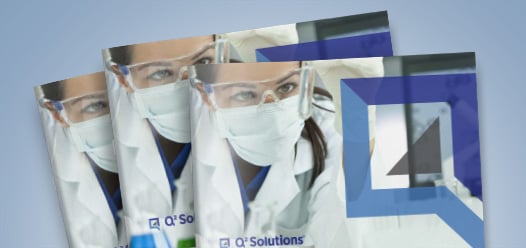Blog
A CRO lab perspective on Ebola vaccine development
This month, during World Immunization Week (April 24-30, 2017), we recognize immunizations as one of the world’s most important and effective health interventions, responsible for saving countless people of all ages from disease and death. The theme for 2017 World Immunization Week is #VaccinesWork. Over the last 3 years, Ebola vaccine research has transitioned from lightly funded research in the public health arena to both biotech companies and large pharma. New approaches to vaccine design have been brought to the mainstream allowing them to address other emerging and established infectious diseases. Remarkably, new vaccine designs for Ebola are already being applied to the Zika outbreak.
Other novel design candidates including DNA vaccines, non-infectious virus-like designs and new vectors are being applied to Zika and other emerging pathogens, as well.
A fragmented marketplace requires global collaboration
Q2 Solutions’ collaboration to develop the first-in-class Ebola enzyme-linked immunosorbent assay (ELISA) began in October 2014 with the licensure of the US Army’s technology to assess Ebola vaccine immunogenicity. The alliance expanded in early 2015 when a consortium of US government agencies, government contractors, vaccines sponsors, and Q2 Solutions coordinated assay validation requirements and testing so a single Q2 Solutions’ validation package could be provided to the US Food and Drug Administration (FDA) for review. The US FDA accepted Q2 Solutions’ ELISA assay validation, thus allowing Q2 Solutions to date to be the only commercial Contract Research Organization (CRO) laboratory to generate Ebola ELISA immunogenicity data for all vaccine sponsors for their future regulatory submissions.
Strong global coordination was required for vaccine licensure because multiple non-governmental organizations (NGOs), academic institutions, vaccine sponsors, and public health organizations from multiple countries provided support and data gathering for each vaccine. An acceptable trial design had to be individualized for each country based on the internal politics and policies for each country. There were limited vaccine efficacy data from three studies with multiple sponsors in multiple countries. The efficacy data was limited due to the outbreak subsiding as the efficacy trials were being initiated.1
With consideration of all of the various stakeholders and with respect to vaccine licensure, a Clinical Research laboratory must provide expertise in the laboratory tools and services that will provide immunogenicity data (and efficacy data where applicable) deemed acceptable by regulatory authorities. A good knowledge of the acceptance criteria of regulatory authorities in immunogenicity data can shorten the time to licensure.
Next steps for Vaccine Licensure
Functional assays
Functional assays for an Ebola vaccine licensure provide a second immunogenicity tool that is believed to be a better measure of the effectiveness of the antibodies generated in response to vaccines. Whereas ELISA measures the quantity of antibody generated, functional assays measure the ability of those antibodies to inhibit virus entry and/or infection of cells in vitro. Functional assays to be used for the Ebola vaccine include:
- pseudovirion (non-infectious virus-like particles) inhibition
- viral neutralization of wild type Ebola virus (limited availability due to requirement for biosafety level 4 [BSL-4] containment facilities)
- replicating vesicular stomatitis virus (VSV)-Ebola viral neutralization, and
- non-replicating VSV-Ebola viral neutralization.
The Animal Rule
The Animal Rule is intended to be used where generating efficacy data in humans is neither feasible nor ethical. The Animal Rule has only been applied to one previous vaccine, Anthrax.2 For Ebola clinical trials it is not ethical to institute placebo-controlled studies where potential life-saving interventions are intentionally withheld from subjects. The Animal Rule allows the alignment of immunogenicity data in humans, immunogenicity in non-human primates, and the vaccine efficacy in non-human primates to determine if a correlate of immunity in non-human primates can be extrapolated to humans.3
Selecting the right laboratory methods and platforms to support vaccine development
There are two critical questions to ask when considering laboratory tools to support development of a new vaccine. First, are tools to discriminate wild type from vaccine needed? Some vaccine candidates are based on live viruses to deliver the immunogen in the subject, and those vaccines may be capable of replicating in the subject receiving the vaccine. There is a need to develop tools that detect and measure the quantity of replicating vaccine in the subject. In Ebola, that tool must discriminate the vaccine being given from an infection with the wild type Ebola virus.
Second, are the critical materials for this vaccine development available? This includes the vaccine candidate, or “vector”, to ensure it is detected and to determine whether a live virus or a surrogate is required. Since using the wild-type virus cannot be done outside of a BSL-4 facility, comparing the detection tool to the wild-type virus is typically not possible. That makes the tool design crucial to ensure wild-type is not detected.
It is unclear how the end of the Ebola pandemic will affect the Ebola vaccine market. Indeed the greatest challenges within Ebola vaccine research today include determining the efficacy of vaccine candidates and ensuring continued funding without ongoing transmission. Unfortunately, the lack of pharmaceutical investment for a spectrum of infectious diseases in resource poor parts of the world creates a perfect storm for a pandemic. As Ebola outbreaks are typically in resource-poor areas, distribution of Ebola vaccines may be dictated more by distribution capabilities of health organizations and NGOs as much as the local political climate. In an ideal world, best practices for rapid development and regulatory approvals would be established to allow vaccine development for diseases such as Ebola to move from a reactive to a proactive approach. Early engagement of lab CROs for method, platform, and data output development would strengthen our positioning against future outbreaks. Having appropriate tools such as functional and molecular assays, multiple platforms that are appropriate for the study, and data harmonization strategies available would help ease the flow of regulatory and quality processes across a global footprint to ensure a regulator-ready data package.
Related Services:
References
- Hanao-Restrepo AM, Camacho A, Longini IM, et al. Efficacy and effectiveness of an rVSV-vectored vaccine in preventing Ebola virus disease: final results from the Guinea ring vaccination, open-label, cluster-randomised trial (Ebola Ça suffit!). Lancet 2017;389(10068):505-18.
- https://www.statnews.com/2015/11/23/anthrax-vaccine-animal-rule/
- US Department of Health and Human Services. Food and Drug Administration. Product Development under the animal rule: Guidance for Industry. Silver Spring, MD. October 2015.
Related Services & Solutions
Related Thought Leaders Insights
AI in Pathology: Advancements, Challenges, and the Road Ahead
In this episode Dr. Monika Lamba Saini and Bruno Larvol of “LARVOL & Friends” discuss the role of artificial intelligence (AI) in pathology and its potential impact on healthcare. They delve into...
Your clinical trial sample tracking solution — enhanced
Subject samples are the lifeblood of your clinical trials. To be successful, you need a unique solution that can track samples through their full lifecycles — across the ecosystem of sites, labs,...
State-of-the-art Clinical Laboratory Services
Recently expanded to nearly 165,000-square-feet, our state-of-the-art laboratory is equipped with a broad spectrum of enhanced scientific solutions for genomics, flow cytometry, translational science...








